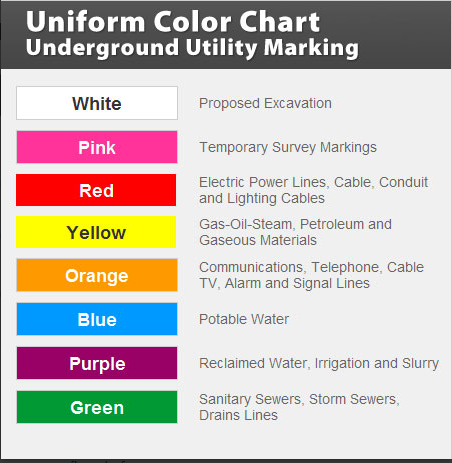The American Public Works Association (APWA) color codes play an indispensable role in infrastructure safety and maintenance. These colors, applied across the United States, are used to mark the locations and pathways of underground utilities. Ensuring safety and efficiency during excavation and maintenance operations. Each APWA color denotes a specific type of utility. Aiding in immediate identification and reducing the risk of accidental damages that could be costly and dangerous.
APWA for Marking & Utilities
Firstly, APWA colors are widely used in a range of products designed for safety and utility management. Particularly in marking the presence and routes of underground utilities. These products include Krylon, Ameri-Stripe, or Seymour brand marking paints and chalks for temporary or permanent marking. As well as Presco marking flags and tapes used to signal the presence of different types of utilities at various depths. Each color-coded product serves as a critical visual communication tool that enhances visibility and awareness. Thereby preventing accidental damage during construction activities and reducing risks associated with underground utilities.
Additionally, APWA color codes are essential for aligning with legal regulations that mandate clear marking of utility lines to ensure public safety and operational continuity in urban and industrial environments. Use the following reference guide as a tool to understand what each APWA color means.
Red: Electrical Power Lines
For example, Red markings are critical; they signify electrical power lines, cables, conduit, and lighting cables. This color warns excavators to proceed with extreme caution to avoid disrupting power lines, which can lead to severe injuries or power outages. Whenever red paint, flags, or markers are visible on a job site, additional safety protocols are necessary to manage the inherent risks.
Yellow: Gas, Oil, Steam, Petroleum, or Gaseous Materials
Also, Yellow is the color for caution, and in the APWA code, it signals the presence of gas, oil, steam, petroleum, or other gaseous materials. This color prevents leaks or explosions that might happen if someone accidentally punctures these lines. Utility and construction workers rely on these markings to plan their excavation strategies carefully, ensuring they maintain a safe working environment.
Orange: Communication, Alarm, or Signal Lines, Cables, or Conduit
Additionally, Orange marks communication lines, including telephone, fiber optics, cable TV, and traffic signals. These are essential components of our communication infrastructure, and damaging them can lead to significant communication disruptions. Workers use orange markings to steer clear of these lines during digging, thus preserving vital communication links.
Blue: Potable Water
Moreover, blue markings indicate potable water lines. This color helps protect our access to clean and safe drinking water by preventing the contamination that could result from a ruptured line. Maintaining the integrity of these lines is not just about avoiding water service interruptions; it’s also about safeguarding public health.
Green: Sewers and Drain Lines
Furthermore, green denotes sewers and drain lines. Accidental breaks in these lines can lead to environmental contamination and pose serious public health risks. By marking these in green, workers can take specific precautions to avoid disrupting these lines, thereby protecting waterways and ecosystems from untreated sewage.
Purple: Reclaimed Water, Irrigation, and Slurry Lines
Next, purple markings are less common and indicate reclaimed water, irrigation, and slurry lines. This distinction is vital as more communities turn to sustainable practices, including the use of reclaimed water. Purple ensures the correct handling of these water sources to avoid cross-contamination with potable water systems.
White: Proposed Excavation
Finally, white outlines the areas where excavation is planned. This preemptive marking serves as a critical communication tool among various stakeholders at a construction or excavation site. This includes engineers, utility companies, and city planners. By marking proposed excavation sites in white, all parties can coordinate more effectively, ensuring that existing utilities are not disrupted.
Conclusion
In conclusion, the APWA color code system is a straightforward yet powerful method to ensure public safety and operational efficiency in the handling of utilities. By adhering to these color codes, workers can prevent damage, avoid service disruptions, and ensure that emergency responses are swift and effective, ultimately safeguarding the community and the environment.







